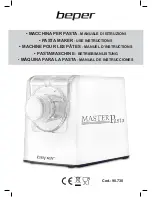
26
English
CLEANING AND SERVICING
A. The appliance
Unplug the appliance from the power socket each time you clean it, and leave to
cool.
Clean the outside of the appliance from time to time with a damp sponge. Clean
and dry the tank, drip tray and grid regularly.
Rinse the inside of the tank regularly.
When a fine white layer clouds your tank, follow the descaling process (see
paragraph
DESCALING
).
Do not use alcohol-based cleaning products or solvents.
After you have unplugged the appliance, regularly clean the grid through which the
water passes, as well as the watertight seal, using a damp sponge (33).
Clean using only a damp cloth without any detergent or scourer.
B. The filter holder
Using a damp cloth, clean the filter holder mount regularly in order to remove
possible coffee residues stuck to the surface (33).
In order to prolong the useful life of the watertight seal on the brewing head, do
not put the filter holder back in place if the coffee machine has not been used for
extended periods.
To remove any deposits that could block the flow of your 1 or 2 cup filter, you may
use the needle (34).
C. The drip tray
This must be emptied each time the appliance is used. If several espressos are prepared
consecutively, it is recommended that you empty it regularly (35-36) (approximately every
five cups). The presence of water is normal and is not a sign of leakage. If necessary,
clean the drip tray and the grid with water and a small amount of mild washing up liquid.
Rinse and dry.
Important: To prevent milk from drying inside the super cappuccino
nozzle, the nozzle must be cleaned after each use. To do so, please
repeat the milk frothing process but instead replace 100 ml of milk with
60 ml of water, and then refer to the next paragraph for manual cleaning.
Maintaining and Cleaning the Super Cappuccino Nozzle
Remove the nozzle from the swivel arm (29). Disassemble it and clean its various
parts using a little brush and some washing-up liquid. Make sure that you thoroughly
clean the parts circled on the photo (30). The hole on the metal part must not be
plugged. The black plastic end of the metal part circled on the photo must be
squeezed to expel any milk remaining inside (31-32). After cleaning and drying, you
can re-assemble the various parts of the nozzle.
Summary of Contents for XP345
Page 3: ...25 26 27 28 29 30 32 31 33 2 1 35 36 34...
Page 70: ...67 A 24 25 super 60 100 ml 26 D1 3 10 7 D1 4 27 0 12 28 super 60ml super 29 30 31 32...
Page 73: ...70 B espresso espresso...
Page 74: ...71 espresso espresso...
Page 75: ...72 super super UHT super...
Page 87: ...84 100 100 1 50 2 50 5 Espresso 1 A B 2 3 4 D1 O D1 1 5 D2 6 7 F 8...
Page 88: ...85 1 2 9 D1 3 10 D1 4 20 11 O D1 1 12 1 2 13 D 1 2 14 4 50 O 15 4 5 D2 3 4 1 6...
Page 89: ...86 7 16 1 2 17 1 1 2 2 18 8 19 D1 2 19 O 15 16 20 21 5 50 60 3 4 6 7 16 1 2 22 8 5 50...
Page 90: ...87 23 23 24 25 60 100 26 D1 3 10 7 D1 4 27 0 12 28 100 60 29 30 31 32...
Page 91: ...88 A 33 B 33 1 2 34 C 35 36 5...
Page 92: ...89 A 8 1 2 13 D1 O D1 1 5 1 6 D1 D1 2 1 4 D1 D1 2 5 10 2 19 19 30 30 7 1 8 6 7 20 4 3 2 20 3 2...
Page 93: ...90 9 D1 D1 4 D1 3 6 O D1 1 12 2 3 2 4 C 2 3...
Page 94: ...91 B...
Page 95: ...92...
Page 96: ...93...
Page 98: ...95 100 1 50 2 2 50 5 1 A B 2 3 4 D1 O D1 1 5 D2 6 7 F 8 9 D1 3 10 D1 4 20 11 0 D1 1 12...
Page 99: ...96 13 D 1 2 14 4 50 O 15 4 5 D2 3 4 1 6 7 16 1 2 17 1 1 2 2 18 8...
Page 100: ...97 19 D1 2 19 O 15 16 20 21 5 50 60 3 4 6 7 16 22 8 5 50 23 23 24 25 60 100 26...
Page 101: ...98 A 33 B 33 D1 3 10 7 D1 4 27 0 12 28 100 60 29 30 31 32...
Page 102: ...99 1 2 34 C 35 36 5 A B 19 th 19 30 th 30 th 7 1 8 6 7 20 4 3 2 20 3 2 A 8 13 D1 O D1 1 5...
Page 103: ...100 1 6 D1 D1 2 1 4 D1 D1 2 5 10 2 B 9 D1 D1 4 D1 3 6 0 D1 1 12 2 3 2 4 C 2 3...
Page 104: ...101 B...
Page 105: ...102...
Page 106: ...103...
















































